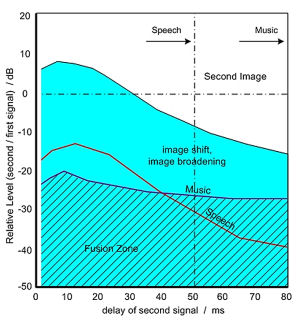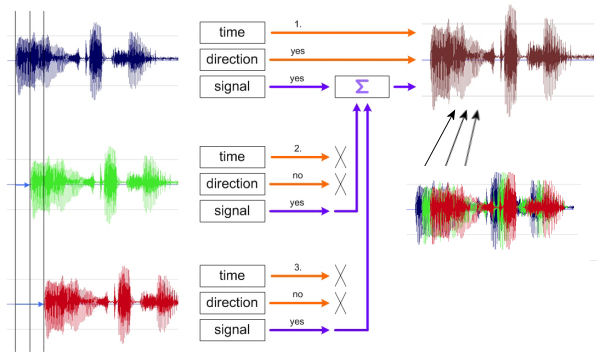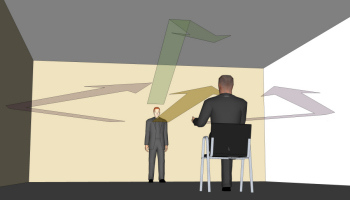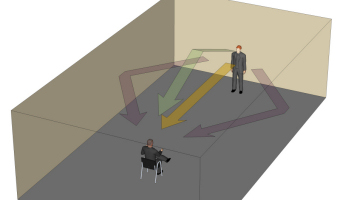Fusion Zone, Image Shift and Second Image

The Precedence effect is a psychoacoustic effect, also known as the law of the first wave front or Haas Effect. Hearing the same signal twice or more and slightly delayed (1 to 50 msec), the perceived direction is determined by the first arriving signal, the later arriving signals improve the perceived signal strength but don't influence the perception of direction. This phenomenon was developed probably millions of years ago in the evolutionary process: A threat signalled by a sound can be handled successfully only if the direction of the threat is known. In the moment a strong reflection disturbs the perception of direction, the threat can not be judged correctly anymore... this can be deadly!
Helmut Haas described this effect first in his doctoral dissertation "Ueber den Einfluss eines Einfach-Echos auf die Hoersamkeit von Sprache" published in 'Acoustica' in 1951 with a more basic setup. Two speakers were separated by 45 degrees in front of the test persons. After delaying one speaker the test person was asked to raise the level of this speaker until it was perceived with the same loudness.
In sound reinforcement systems the effect is used to make a delay speaker system unheard by delaying it more than the actual distance would define. This way the sound signal's direction from the delayed speaker is oppressed in our brains but the sound energy will work properly to enhance the sound signal in the desired way. For a delayed signal (up to about 20 msec) a level increase of up to 10 dB is needed for the second signal to become audible.
In relation between delay time and level difference a so-called fusion zone emerges. In the fusion zone (green) the delayed signal doesn't give the impression of a second image with its own directivity. With the raised level of the delayed signal (smaller level difference) it can be detected (Detection Threshold, the effect of improved signal strength). With a further raised level of the delayed signal a slight image shift will be audible (Image Shift Threshold). From a certain point the effect falls apart and a second image is audible (Second Image Threshold).

The thresholds are different for click noises, speech and more complex signals as music. The precedence effect for click signals works perfectly for delays in the range of up to 10 msec, the precedence effect for speech can operate successfully even up to 40 msec. With complex signals like music the second delayed signal is much less obviously detected with long delay times of even up to 80 msec. The difference between the perception of speech and music stands in a direct relationship to the 'defined' limits for supporting lateral energy for speech and for music (50 msec and 80 msec).
In sound reinforcement systems the effect is used to make a delay speaker system unheard by delaying it several milliseconds more than the actual distance would suggest. The directivity information of the second signal (delayed signal) is psycho acoustically suppressed but the signal strength is enhanced.

The precedence effect is the basic effect for any kind of hearing in rooms. Reflections from side walls and ceilings improve the signal strength of the original signal but don't disturb the directivity impression (except delays become larger than about 50 msec).


The precedence effect is the cause for the stereo sweet spot. Our brain tries to discover which of both heard signal sources is the original signal and which is probably a reflection of it ..
